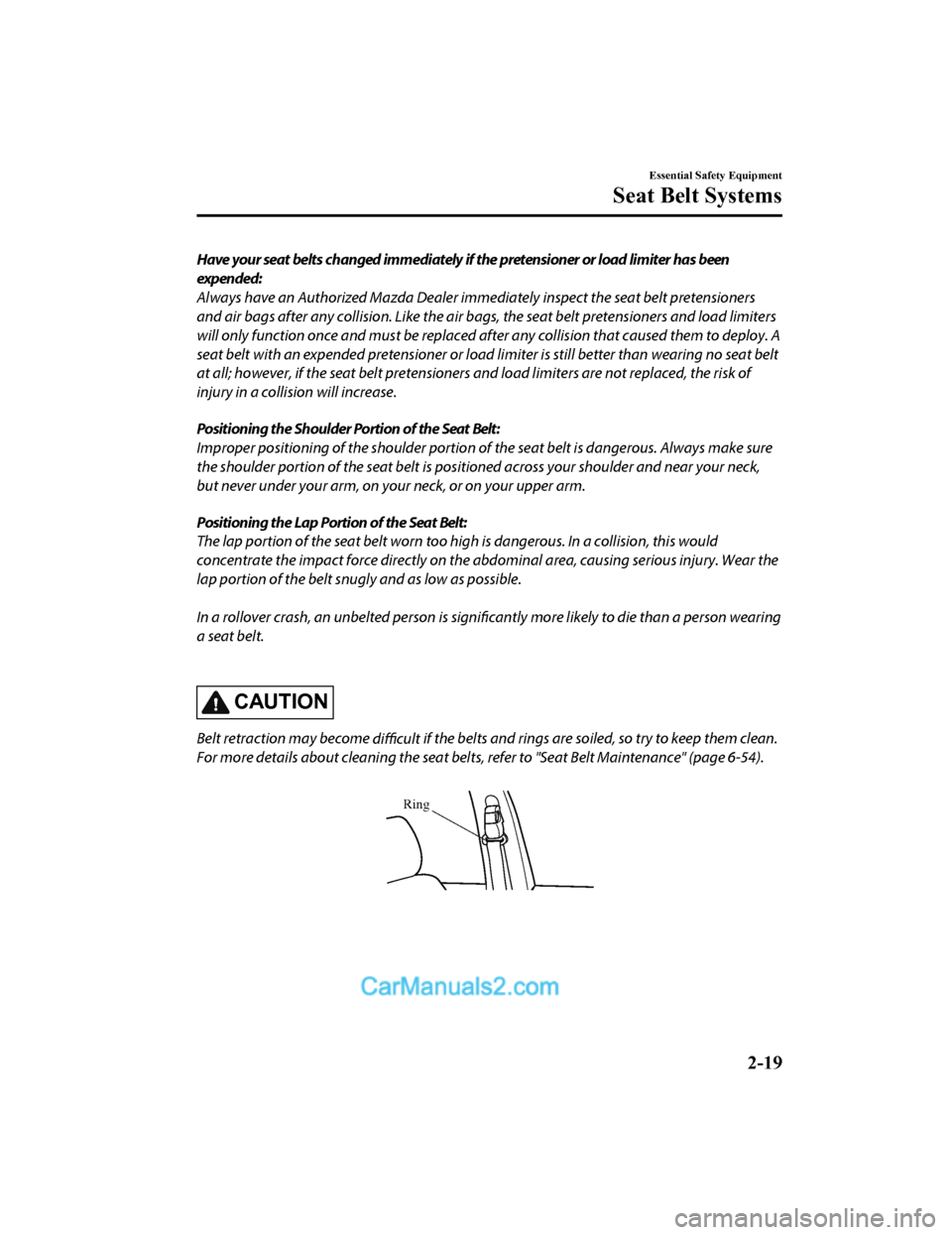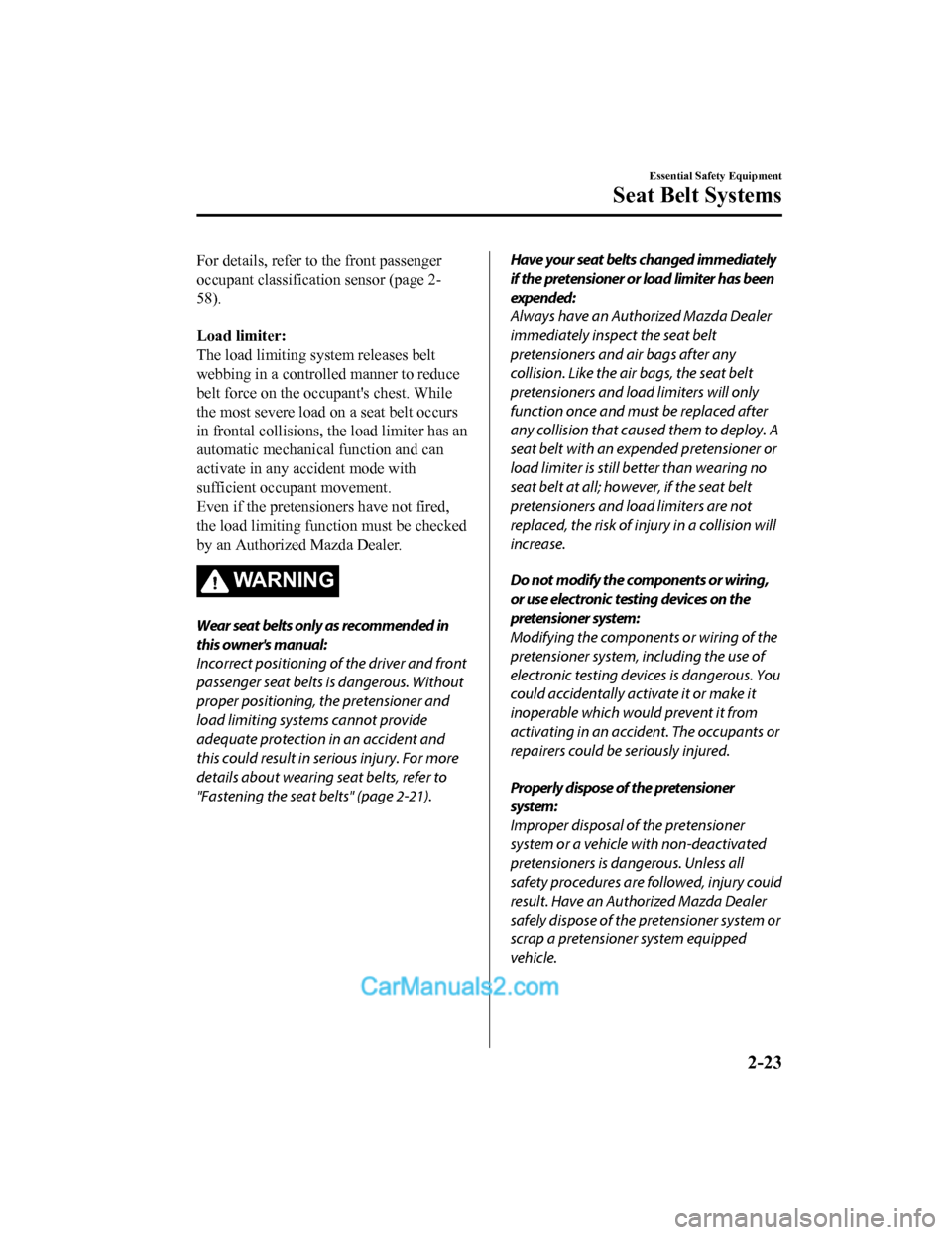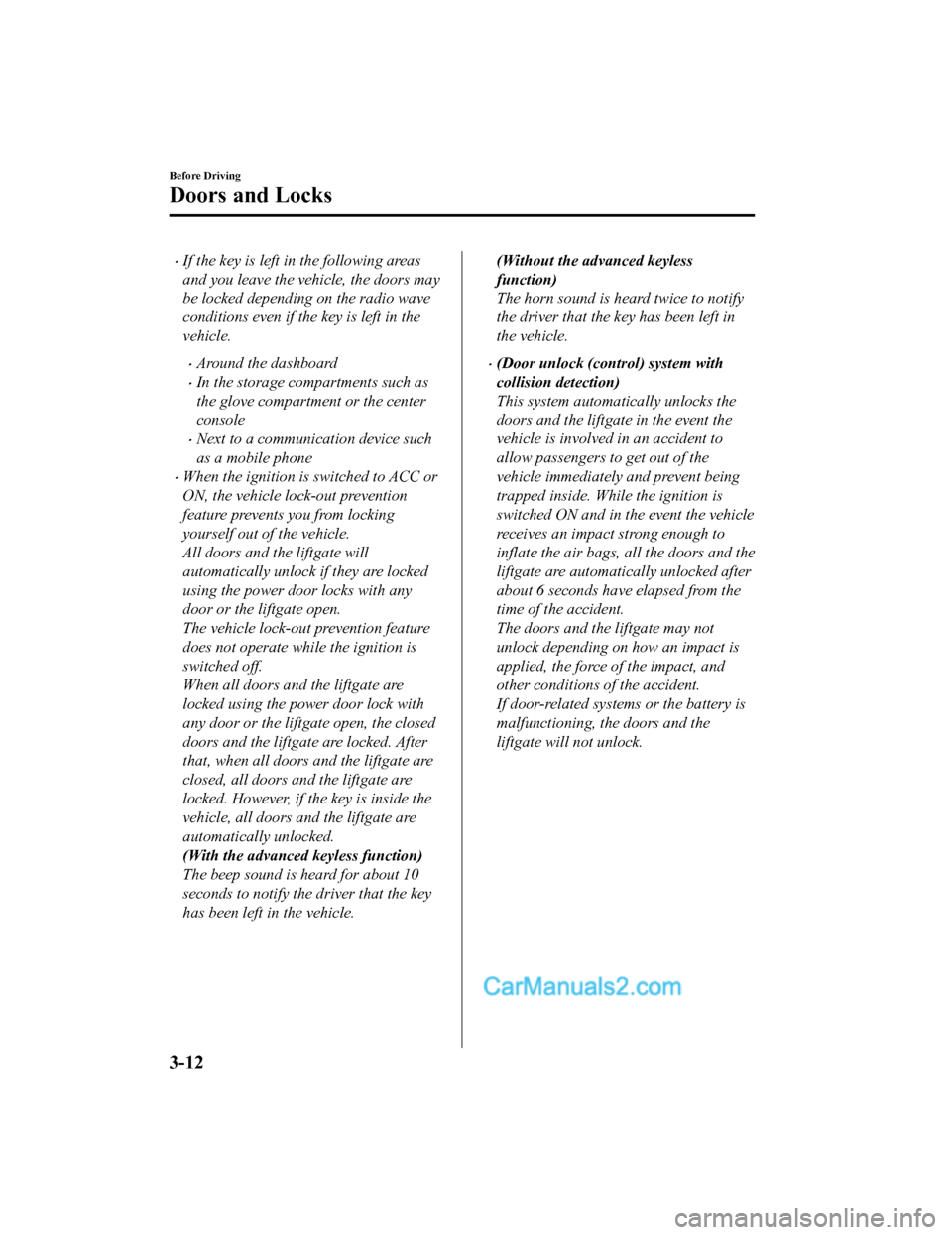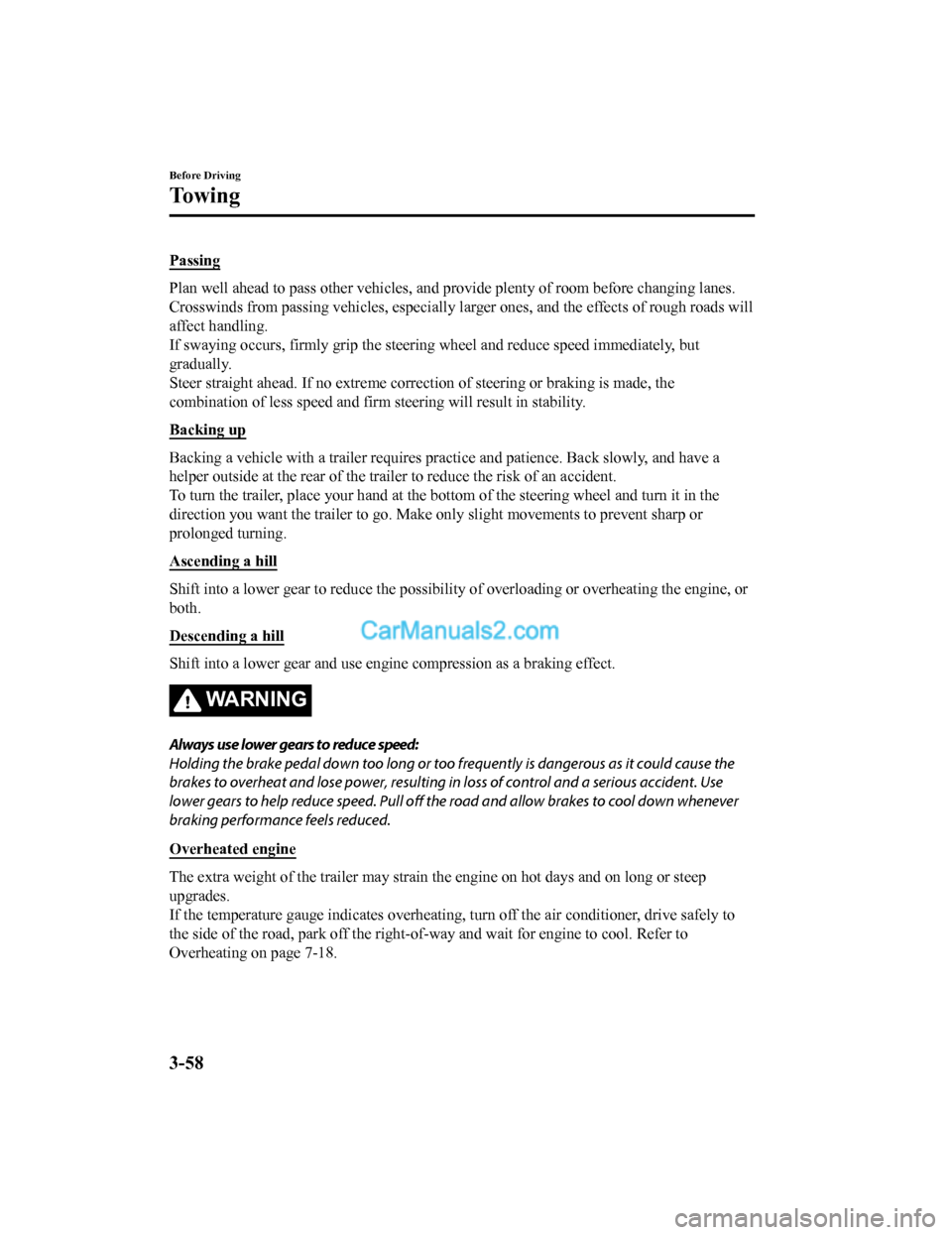Media MAZDA MODEL CX-5 2018 Owners Manual (in English)
[x] Cancel search | Manufacturer: MAZDA, Model Year: 2018, Model line: MODEL CX-5, Model: MAZDA MODEL CX-5 2018Pages: 628, PDF Size: 82.38 MB
Page 33 of 628

Have your seat belts changed immediately if the pretensioner or load limiter has been
expended:
Always have an Authorized Mazda Dealer immediately inspect the seat belt pretensioners
and air bags after any collision. Like the air bags , the seat belt pretensioners and load limiters
will only function once and must be replaced af ter any collision that caused them to deploy. A
seat belt with an expended pretensioner or load limiter is still better than wearing no seat belt
at all; however, if the seat belt pretensioner s and load limiters are not replaced, the risk of
injury in a collision will increase.
Positioning the Shoulder Portion of the Seat Belt:
Improper positioning of the shoulder portion of the seat belt is dangerous. Always make sure
the shoulder portion of the seat belt is positi oned across your shoulder and near your neck,
but never under your arm, on your neck, or on your upper arm.
Positioning the Lap Portion of the Seat Belt:
The lap portion of the seat belt worn too high is dangerous. In a collision, this would
concentrate the impact force directly on the abdominal area, causing serious injury. Wear the
lap portion of the belt snugly and as low as possible.
In a rollover crash, an unbelted person is significantly more likely to die than a person wearing
a seat belt.
CAUTION
Belt retraction may become difficult if the belts and rings are soiled, so try to keep them clean.
For more details about cleaning the seat belts, refer to "Seat Belt Maintenance" (page 6-54).
Ring
Essential Safety Equipment
Seat Belt Systems
2-19
CX-5_8GN5-EA-17J_Edition1 2017-8-18 12:58:27
Page 37 of 628

For details, refer to the front passenger
occupant classification sensor (page 2-
58).
Load limiter:
The load limiting system releases belt
webbing in a controlled manner to reduce
belt force on the occupant's chest. While
the most severe load on a seat belt occurs
in frontal collisions, the load limiter has an
automatic mechanical function and can
activate in any accident mode with
sufficient occupant movement.
Even if the pretensioners have not fired,
the load limiting function must be checked
by an Authorized Mazda Dealer.
WA R N I N G
Wear seat belts only as recommended in
this owner's manual:
Incorrect positioning of the driver and front
passenger seat belts is dangerous. Without
proper positioning, the pretensioner and
load limiting systems cannot provide
adequate protection in an accident and
this could result in serious injury. For more
details about wearing seat belts, refer to
"Fastening the seat belts" (page 2-21).
Have your seat belts changed immediately
if the pretensioner or load limiter has been
expended:
Always have an Authorized Mazda Dealer
immediately inspect the seat belt
pretensioners and air bags after any
collision. Like the air bags, the seat belt
pretensioners and load limiters will only
function once and must be replaced after
any collision that caused them to deploy. A
seat belt with an expended pretensioner or
load limiter is still better than wearing no
seat belt at all; however, if the seat belt
pretensioners and load limiters are not
replaced, the risk of injury in a collision will
increase.
Do not modify the components or wiring,
or use electronic testing devices on the
pretensioner system:
Modifying the components or wiring of the
pretensioner system, including the use of
electronic testing devices is dangerous. You
could accidentally activate it or make it
inoperable which would prevent it from
activating in an accident. The occupants or
repairers could be seriously injured.
Properly dispose of the pretensioner
system:
Improper disposal of the pretensioner
system or a vehicle with non-deactivated
pretensioners is dangerous. Unless all
safety procedures are followed, injury could
result. Have an Authorized Mazda Dealer
safely dispose of the pretensioner system or
scrap a pretensioner system equipped
vehicle.
Essential Safety Equipment
Seat Belt Systems
2-23
CX-5_8GN5-EA-17J_Edition1 2017-8-18 12:58:27
Page 61 of 628

Do not attach objects on or around the area where a side air bag deploys:
Attaching objects to the front seat in such a way as to cover the outboard side of the seat in
any way is dangerous. In an accident the object could interfere with the side air bag, which
inflates from the outboard side of the front seat s, impeding the added protection of the side
air bag system or redirecting the air bag in a way that is dangerous. Furthermore, the bag
could be cut open releasing the gas.
Do not hang net bags, map pouches or backpacks with side straps on the front seats. Never
use seat covers on the front seats. Always keep the side air bag modules in your front seats
free to deploy in the event of a side collision.
Do not attach objects on or around the area where a curtain air bag deploys:
Attaching objects to the areas where the curtain air bag activates such as on the windshield
glass, side door glass, front and rear window p illars and along the roof edge and assist grips is
dangerous. In an accident the object could interfere with the curtain air bag, which inflates
from the front and rear window pillars an d along the roof edge, impeding the added
protection of the curtain air bag system or redirecting the air bag in a way that is dangerous.
Furthermore, the bag could be cut open releasing the gas.
Do not place hangers or any other objects on the assist grips. When hanging clothes, hang
them on the coat hook directly. Always keep th e curtain air bag modules free to deploy in the
event of a side collision or roll-over accident.
Do not touch the components of the supplemental restraint system after the air bags have
inflated:
Touching the components of the supplemental restraint system after the air bags have
inflated is dangerous. Immediately after inflation , they are very hot. You could get burned.
Never install any front-end equipment to your vehicle:
Installation of front-end equipment, such as frontal protection bar (kangaroo bar, bull bar,
push bar, or other similar devices), snowplow , or winches, is dangerous. The air bag crash
sensor system could be affected. This could cause air bags to
inflate unexpectedly, or it could
prevent the air bags from infla ting during an accident. Front occupants could be seriously
injured.
Do not modify the suspension:
Modifying the vehicle suspension is dangerous. If the vehicle's height or the suspension is
modified, the vehicle will be unable to accura tely detect a collision or roll-over accident
resulting in incorrect or unexpected air bag depl oyment and the possibility of serious injuries.
Essential Safety Equipment
SRS Air Bags
2-47
CX-5_8GN5-EA-17J_Edition1 2017-8-18 12:58:27
Page 88 of 628

ŌĆóIf the key is left in the following areas
and you leave the vehicle, the doors may
be locked depending on the radio wave
conditions even if the key is left in the
vehicle.
ŌĆóAround the dashboard
ŌĆóIn the storage compartments such as
the glove compartment or the center
console
ŌĆóNext to a communication device such
as a mobile phone
ŌĆóWhen the ignition is switched to ACC or
ON, the vehicle lock-out prevention
feature prevents you from locking
yourself out of the vehicle.
All doors and the liftgate will
automatically unlock if they are locked
using the power door locks with any
door or the liftgate open.
The vehicle lock-out prevention feature
does not operate while the ignition is
switched off.
When all doors and the liftgate are
locked using the power door lock with
any door or the liftgate open, the closed
doors and the liftgate are locked. After
that, when all doors and the liftgate are
closed, all doors and the liftgate are
locked. However, if the key is inside the
vehicle, all doors and the liftgate are
automatically unlocked.
(With the advanced keyless function)
The beep sound is heard for about 10
seconds to notify the driver that the key
has been left in the vehicle.
(Without the advanced keyless
function)
The horn sound is heard twice to notify
the driver that the key has been left in
the vehicle.
ŌĆó(Door unlock (control) system with
collision detection)
This system automatically unlocks the
doors and the liftgate in the event the
vehicle is involved in an accident to
allow passengers to get out of the
vehicle immediately and prevent being
trapped inside. While the ignition is
switched ON and in the event the vehicle
receives an impact strong enough to
inflate the air bags, all the doors and the
liftgate are automatically unlocked after
about 6 seconds have elapsed from the
time of the accident.
The doors and the liftgate may not
unlock depending on how an impact is
applied, the force of the impact, and
other conditions of the accident.
If door-related systems or the battery is
malfunctioning, the doors and the
liftgate will not unlock.
Before Driving
Doors and Locks
3-12
CX-5_8GN5-EA-17J_Edition12017-8-18 12:58:27
Page 94 of 628

Ō¢╝Locking, Unlocking with Auxiliary
Key
Turn the auxiliary key toward the front to
lock, toward the
back to unlock.
To l o c k
All doors and the liftgate lock
automatically when th e driver's door is
locked using the auxiliary key.
To u n l o c k
The driverŌĆÖs door unlocks when the
auxiliary key is turned briefly to the
unlock position and then immediately
returned to the center position.
All doors and the liftgate unlock when the
driver's door is unlocked and the auxiliary
key is held in the unlock position for one
second or longer.
Lock Unlock
Ō¢╝
Locking, Unlocking with Door-Lock
Knob
Operation from inside
To lock any door from the inside, press the
door-lock knob.
To unlock, pull it outward.
This does not operate the other door locks.
Lock
Unlock
Unlocked: Red indicator
Before Driving
Doors and Locks
3-18
CX-5_8GN5-EA-17J_Edition1
2017-8-18 12:58:27
Page 106 of 628

Ō¢╝Engine Exhaust (Carbon monoxide)
WA R N I N G
Do not drive your vehicle if you smell exhaust gas inside the vehicle:
Engine exhaust gas is dangerous. This gas contai
ns carbon monoxide (CO), which is colorless,
odorless, and poisonous. When inhaled, it can cause loss of consciousness and death. If you
smell exhaust gas inside the vehicle, keep a ll windows fully open and contact an Authorized
Mazda Dealer immediately.
Do not run the engine when inside an enclosed area:
Running the engine inside an enclosed area, such as a garage, is dangerous. Exhaust gas,
which contains poisonous carbon monoxide , could easily enter the cabin. Loss of
consciousness or even death could occur.
Open the windows or adjust the heating or cooling system to draw fresh air when idling the
engine:
Exhaust gas is dangerous. When the vehicle is stopped with the windows closed and the
engine running for a long time even in an op en area, exhaust gas, which contains poisonous
carbon monoxide, could enter the cabin. Loss of consciousness or even death could occur.
Clear snow from underneath and around your vehicle, particularly the tail pipe, before
starting the engine:
Running the engine when a vehi cle is stopped in deep snow is dangerous. The exhaust pipe
could be blocked by the snow, allowing exhaust gas to enter the cabin. Because exhaust gas
contains poisonous carbon monoxide, it could cause loss of consciousness or even death to
occupants in the cabin.
Before Driving
Fuel and Emission
3-30
CX-5_8GN5-EA-17J_Edition1 2017-8-18 12:58:27
Page 134 of 628

Passing
Plan well ahead to pass other vehicles, and provide plenty of r oom before changing lanes.
Crosswinds from passing vehicles, especially larger ones, and t he effects of rough roads will
affect handling.
If swaying occurs, firmly grip the steering wheel and reduce sp eed immediately, but
gradually.
Steer straight ahead. If no extr eme correction of steering or b raking is made, the
combination of less speed and firm steering will result in stab ility.
Backing up
Backing a vehicle with a traile r requires practice and patience . Back slowly, and have a
helper outside at the rear of th e trailer to reduce the risk of an accident.
To turn the trailer, place your ha nd at the bottom of the steering wheel and turn it in the
direction you want the trailer to go. Make only slight movement s to prevent sharp or
prolonged turning.
Ascending a hill
Shift into a lower gear to redu ce the possibility of overloadin g or overheating the engine, or
both.
Descending a hill
Shift into a lower gear and use engine compression as a braking effect.
WA R N I N G
Always use lower gears to reduce speed:
Holding the brake pedal down too long or too frequently is dangerous as it could cause the
brakes to overheat and lose power, resulting in loss of control and a serious accident. Use
lower gears to help reduce speed. Pull off th e road and allow brakes to cool down whenever
braking performance feels reduced.
Overheated engine
The extra weight of the trailer may strain the engine on hot days and on long or steep
upgrades.
If the temperature gauge indicates overheating, turn off the ai r conditioner, drive safely to
the side of the road, park off the right-of-way and wait for en gine to cool. Refer to
Overheating on page 7-18.
Before Driving
To w i n g
3-58
CX-5_8GN5-EA-17J_Edition1 2017-8-18 12:58:27
Page 146 of 628

Turning the Engine Off
WA R N I N G
Do not stop the engine while the vehicle is
moving:
Stopping the engine while the vehicle is
moving for any reason other than in an
emergency is dangerous. Stopping the
engine while the vehicle is moving will
result in reduced braking ability due to the
loss of power braking, which could cause
an accident and serious injury.
1. Stop the vehicle completely.
2. Shift the selector lever to the Pposition and set the parking brake.
3. Press the push button start to turn off the engine. The ignition position is off.
CAUTION
’āśWhen leaving the vehicle, make sure the
push button start is off.
NOTE
ŌĆóThe cooling fan in the engine
compartment could turn on for a few
minutes after the i gnition is switched
from ON to OFF, whether or not the A/C
is on or off, to cool the engine
compartment quickly.
ŌĆóIf the system detects that the remaining
battery power of the key is low when the
ignition is switched from ON to ACC or
OFF, the following is indicated.
Replace with a new battery before the
key becomes unusable.
Refer to Key Battery Replacement on
page 6-29.
(Vehicle equipped with Type A
instrument cluster)
A message is indicated in the display of
the instrument cluster.
(Vehicle equipped with Type B
instrument cluster)
The KEY indicator li ght (green) flashes
for approximately 30 seconds.
Refer to Warning/Indicator Lights on
page 4-30.
ŌĆóIf the engine is turned off while the
selector lever is in a position other than
P, the ignition switches to ACC.
Ō¢╝ Emergency Engine Stop
Continuously pressing the push button
start or quickly pressi
ng it any number of
times while the engin e is running or the
vehicle is being drive n will turn the engine
off immediately. The ignition switches to
ACC.
When Driving
Start/Stop Engine
4-10
CX-5_8GN5-EA-17J_Edition1 2017-8-18 12:58:27
Page 150 of 628

ŌĆóThe trip record will be erased when:
ŌĆóThe power supply is interrupted
(blown fuse or the battery is
disconnected).
ŌĆóThe vehicle is driven over 9999.9 km
(mile).
Ō¢╝Tachometer
The tachometer shows engine speed in
thousands of revolutions per minute (rpm).
CAUTION
Do not run the engine with the tachometer
needle in the RED ZONE.
This may cause severe engine damage.
STRIPED
ZONE
RED ZONE
NOTE
When the tachometer needle enters the
STRIPED ZONE, this indicates to the
driver that the gears should be shifted
before entering the RED ZONE.
Ō¢╝ Engine Coolant Temperature Gauge
(Without Multi-information
Display)
Displays the engine coolant temperature.
The white gauge indicates that the engine
coolant temperature is low, and the red
gauge indicates that the engine coolant
temperature is high and overheating.
CAUTION
If the engine coolant temperature gauge
indicator flashes, there is a possibility of
overheating. Park the vehicle in a safe
place immediately an
d take appropriate
measures. If the vehicle continues to be
driven, it could cause damage to the
engine.
Refer to Overheating on page 7-18.
NOTE
ŌĆóThe temperature unit (Centigrade/
Fahrenheit) of the engine coolant gauge
display changes in conjunction with the
temperature unit of the outside
temperature display.
Refer to Personalization Features on
page 9-9.
ŌĆóDuring normal driving, the engine
coolant temperature stabilizes at 100 ┬░C
(210 ┬░F) or less, and the gauge indicates
a range lower than 100 ┬░C (210 ┬░F).
When Driving
Instrument Cluster and Display
4-14
CX-5_8GN5-EA-17J_Edition1 2017-8-18 12:58:27
Page 158 of 628

Ō¢╝Engine Coolant Temperature Gauge
Displays the engine coolant temperature.
The blue gauge indicates that the engine
coolant temperature is low, and the red
gauge indicates that the engine coolant
temperature is high and overheating.
CAUTION
If the high engine coolant temperature
warning light (red) turns on, there is a
possibility of overheating. Park the vehicle
in a safe place immediately and take
appropriate measures. If the vehicle
continues to be driven, it could cause
damage to the engine.
Refer to Overheating on page 7-18.
NOTE
ŌĆóThe temperature unit (Centigrade/
Fahrenheit) of the engine coolant gauge
display changes in conjunction with the
temperature unit of the outside
temperature display.
Refer to Personalization Features on
page 9-9.
ŌĆóDuring normal driving, the engine
coolant temperature stabilizes at 100 ┬░C
(210 ┬░F) or less, and the gauge indicates
a range lower than 100 ┬░C (210 ┬░F).
Ō¢╝ Fuel Gauge
The fuel gauge shows approximately how
much fuel is remaining in the tank when
the ignition is switched ON. We
recommend keeping the tank over 1/4 full.
Full
1/4 Full
Empty
If the fuel level is low, () and () turn an
amber color. Refuel as soon as possible.
Refer to Taking Action on page 7-33 .
NOTE
ŌĆóAfter refueling, it may require some time
for the indicator to st abilize. In addition,
the indicator may deviate while driving
on a slope or curve since the fuel moves
in the tank.
ŌĆóThe display indicating a quarter or less
remaining fuel has more segments to
show the remaining fu el level in greater
detail.
ŌĆóThe direction of the arrow () indicates
that the fuel-filler lid is on the left side
of the vehicle.
When Driving
Instrument Cluster and Display
4-22
CX-5_8GN5-EA-17J_Edition1 2017-8-18 12:58:27